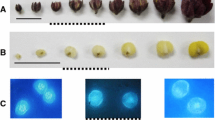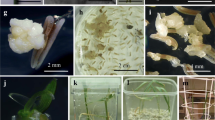Abstract
Anthers containing microspores at the uninucleate stage were excised from capitula of field grown plants of purple coneflower, Echinacea purpurea, and cultured on medium conducive to callus growth. In callus induction cultures, N6 basal medium was more effective than Murashige and Skoog (MS), and a combination of benzyladenine (BA) at 2.22 µM with naphthaleneacetic acid (NAA) at 0.054 µM was more effective than 2,4-dichlorophenoxyacetic acid (2,4-D) alone at 4.52, 9.05 and 13.57 µM. Callus induction rate as high as 85.8% was achieved, and no statistically significant differences were found among cultures with various densities of 20, 40, 60, 80 and 100 anthers per bottle each filled with 40-ml medium. Shoots were regenerated from calluses on MS medium containing 2.22 µM BA and various concentrations of NAA, with the highest regeneration rate of 95.24% obtained when 0.27 µM NAA was applied. Although a large portion of the␣regenerated shoots had prominent symptom of vitrification, some normal shoots could be easily rooted on MS medium containing 0.054 µM NAA. Thirty regenerated plants were randomly selected and 19 of them were confirmed to be haploid by observation of chromosome number of root-tip cells.
Similar content being viewed by others
Abbreviations
- BA:
-
benzyladenine
- NAA:
-
naphthaleneacetic acid
- 2,4-D:
-
2,4-dichlorophenoxyacetic acid
- MS:
-
Murashige and Skoog (1962)
References
Barrett B (2003) Medicinal properties of Echinacea: a critical review. Phytomedicine 10:66–86
Bauer R (1999) Chemistry, analysis and immunological investigations of Echinacea phytopharmaceuticals. In: Wagner H (ed) Immunomodulatory agents from plants. Birkhauser Verlag. pp 41–88
Bhatti S, Aziz AN, Sauve R (2001) Anther culture response of Echinacea cultivars. 23rd Annual University-Wide Research Symposium, Tennessee State University, Nashville, TN, March 20–21, p 39
Borrino EM, Powell W (1988) Stomata guard cell length as an indicator of ploidy in microspore-derived plants of barley. Genome 30:158–160
Choffe KL, Victor JMR, Murch SJ, Saxena PK (2000) In vitro regeneration of Echinacea L.: direct somatic embryogenesis and indirect shoot organogensis in petiole culture. In Vitro Cell Dev Biol Plant 36:30–36
Chu CC, Wang CC, Su CS (1975) Establishment of an efficient medium for anther culture of rice through comparative experiments on the nitrogen sources. Sci Sin 18:659–668
Gu XF, Yang AF, Meng H, Zhang JR (2005) In vitro induction of tetraploid plants from diploid Zizyphus jujuba Mill. cv. Zhanhua. Plant Cell Rep 24:671–676
Harbage JF (2001) Micropropagation of Echinacea angustifolia, E. pallida and E. purpurea from stem and seed explants. Hortscience 36:360–364
Hobbs CR (1994) Echinacea – a literature review. Herbalgram 30:33–49
Kao TH, McCubbin AG (1996) How flowering plants discriminate between self and non-self pollen to prevent␣inbreeding. Proc Natl Acad Sci USA 93:12059–12065
Koroch A, Juliani HR, Kapteyn J, Simon JE (2002) In vitro regeneration of Echinacea purpurea from leaf explants. Plant Cell Tiss Organ Cult 69:79–83
Kuhlman U, Foroughi B (1989) Production of doubled haploid lines in frequencies sufficient for barley breeding programs. Plant Cell Rep 8:78–81
Lakshmanan P, Danesh M, Taji A (2002) Production of four commercially cultivated Echinacea species by different methods of in vitro regeneration. J Horticult Sci Biotech 77:158–163
Lee SY, Kim HS, Kwon TO (2004) Variation in anther culture response and fertility of backcrossed hybrids between indica and japonica rice (Oryza sativa). Plant Cell Tiss Organ Cult 79:25–30
Li TCS (1998) Echinacea: cultivation and medicinal value. HortTechnology 8:122–129
McKeown KA (1999) A review of taxonomy of the genus Echinacea. In: Janick J (eds) Perspectives on new crops and new uses, Purdue University, West Lafayette, pp 482–490
Mechanda SM, Baum BR (2003) Direct shoot regeneration from leaf segments of mature plants of Echinacea purpurea (L.) Moench. In Vitro Cell Dev Biol Plant 39:505–509
Murashige T, Skoog F (1962) A revised medium for rapid growth and bioassays with tobacco tissue cultures. Physiol Plant 15:473–497
Portela de Carvalho JFR, Roberto de Carvalho C, Otoni WC (2005) In vitro induction of polyploidy in annatto (Bixa orellana). Plant Cell Tiss Organ Cult 80:69–75
Qu L, Wang X, Hood E, Wang M, Scalzo R (2004) Chromosome karyotypes of Echinacea angustifolia var. angustifolia and E. purpurea. HortScience 39:368–370
Sauve RJ, Mmbaga MT, Zhou S (2004) In vitro regeneration of the Tennessee coneflower (Echinacea tennesseensis). In Vitro Cell Dev Biol Plant 40:325–328
Sejdler LK, Dabrowska J (1996) Studies on the biology of flowering and fruiting of purple coneflower (Echinacea purpurea Moench). Pt. 1. Biology of flowering and fruiting. Herba Polonica 42:83–87
Silva NF, Goring DR (2001) Mechanisms of self-incompatibility in flowering plants. Cell Mol Life Sci 58:1988–2007
Thao NTP, Ureshino K, Miyajima I, Ozaki Y, Okubo H (2003) Induction of tetraploids in ornamental Alocasia through colchicine and oryzalin treatments. Plant Cell Tiss Organ Cult 72:19–25
Ziauddin A, Marsolais A, Simion E (1992) Improved plant regeneration from wheat anther and barley microspore culture using phenylacetic acid (PAA). Plant Cell Rep 11:489–498
Zobayed SMA, Saxena PK (2003) In vitro regeneration of Echinacea purpurea L.: enhancement of somatic embryogenesis by indole butyric acid and dark pre-incubation. In Vitro Cell Dev Biol Plant 39:605–612
Acknowledgements
This research was supported by a grand (2004Z3-E5021) from the Science and Technology Bureau of the Guangzhou Municipal Government.
Author information
Authors and Affiliations
Corresponding author
Rights and permissions
About this article
Cite this article
Zhao, FC., Nilanthi, D., Yang, YS. et al. Anther culture and haploid plant regeneration in purple coneflower (Echinacea purpurea L.). Plant Cell Tiss Organ Cult 86, 55–62 (2006). https://doi.org/10.1007/s11240-006-9096-0
Received:
Accepted:
Published:
Issue Date:
DOI: https://doi.org/10.1007/s11240-006-9096-0




